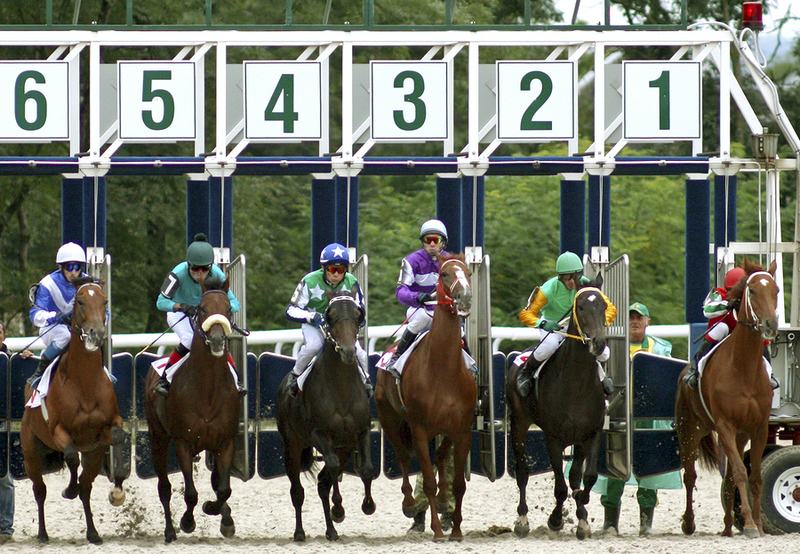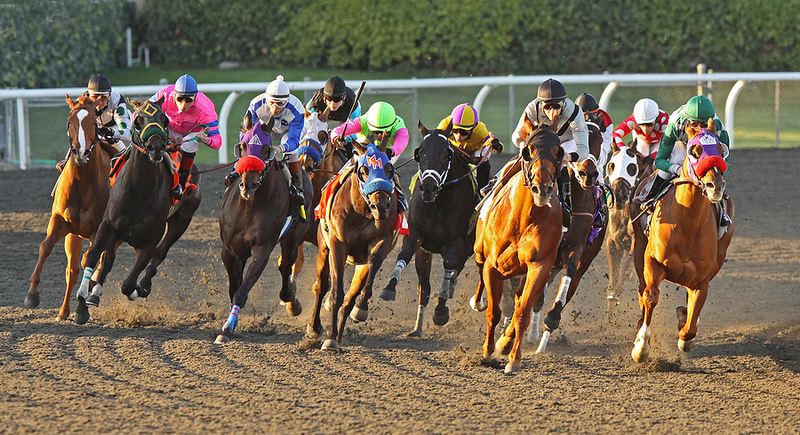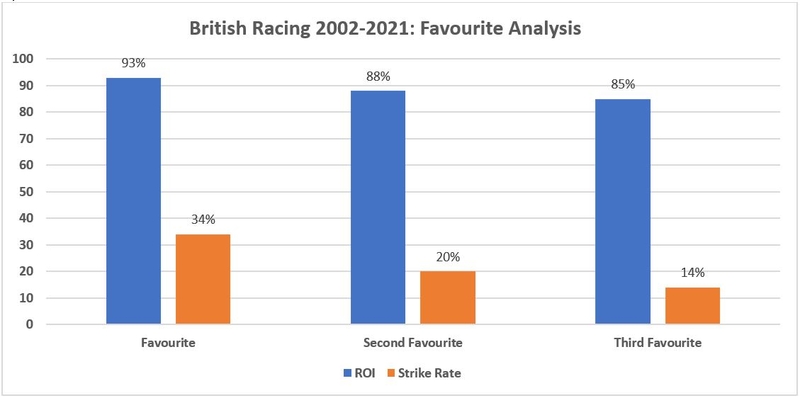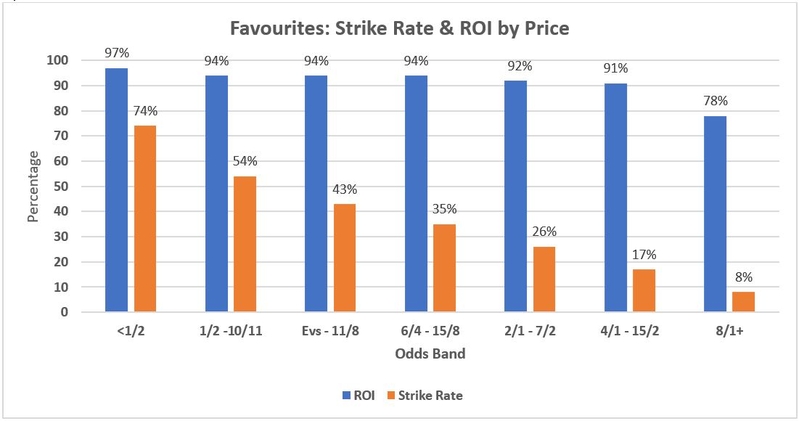The betting world contains many words and phrases that may be unfamiliar to the uninitiated – one of the most common being the widely used “favourite”.
You likely won’t need to watch the latest racing coverage for too long before hearing soundbites such as “The favourite looks like he will be hard to beat here” or “This favourite looks worth taking on”. But what are they all talking about? Why are certain runners labelled as favourites? Do they always come home in front? And if not, how often do they win?
Here we answer all of the above and, whilst sticking to horse racing for our explanations in this article, the same concepts apply across all sporting events.
What is a Favourite?
 In any race, the favourite is simply the shortest-priced runner in the betting market and, therefore, the horse deemed most likely to win.
In any race, the favourite is simply the shortest-priced runner in the betting market and, therefore, the horse deemed most likely to win.
Turning to football for a second, if Manchester City were playing Luton Town at home, anyone with even a passing interest in the sport would be aware that City would be strong “favourites” to win the game as a combination of playing at home, and most crucially, being a much better team.
The same is true in racing, where – by virtue of current form, overall level of talent, or race conditions – some runners have a higher chance of winning than others.
The horse with the best chance of all – at least in the opinion of the odds compilers and the betting public – will be handed the shortest odds and is known as the favourite.
Joint and Co-Favourites
Whilst the majority of races in the UK will have a single favourite, this is not always the case.
On occasion, two or more runners may enjoy equal status of being the shortest-priced runners in the field. Whenever exactly two horses share this honour, they are known as joint-favourites – denoted by JF.
Should three or more horses be inseparable at the head of the market, they are each labelled as co-favourites – denoted by CF.
Where Does the Term Favourite Come From?
 The term favourite stems from the fact that the shortest-priced runner is generally the most popular horse with the betting public.
The term favourite stems from the fact that the shortest-priced runner is generally the most popular horse with the betting public.
Professional odds compilers produce a list of odds for every race, but these odds may change in relation to the betting stakes they attract. The more money placed on a horse to win, relative to the other runners in the field, the shorter its price will become.
It follows that the shortest-priced runner will have attracted the most money and can therefore be considered the “favourite” choice of punters.
One thing to be aware of is that several alternative terms have emerged to refer to the favourite in a race – the most popular of which are market leader and ‘jolly’.
The reasoning behind market leader is self-explanatory, i.e. the horse at the top of the betting market, whilst “jolly” recalls the days when excited punters would often refer to the shortest-priced runner as the “jolly old favourite”.
Jolly, market leader, or favourite – they all mean the same.
Favourites Come in All Shapes and Sizes

One important thing to note with favourites is that they are not all created equally.
The favourite will always be the shortest-priced runner in the field, but exactly how short that price is can vary widely.
The following example races help to illustrate this concept.
Race 1: 2023 Juddmonte International Stakes
| Horse | Odds |
|---|---|
| Paddington | 8/15F |
| Mostahdaf | 5/2 |
| Nashwa | 10/1 |
| The Foxes | 16/1 |
Race 2: 2023 Sky Bet Symphony Group Handicap
| Horse | Odds |
|---|---|
| Jm Jungle | 7/1F |
| Intrinsic Bond | 8/1 |
| Mania Scouse | 8/1 |
| Korker | 9/1 |
| Equilateral | 9/1 |
| Alligator Alley | 10/1 |
| Looking For Lynda | 10/1 |
| Copper Knight | 11/1 |
| Mondammej | 12/1 |
| Ventura Express | 16/1 |
| Nomadic Empire | 16/1 |
| Vintage Clarets | 16/1 |
| Bergerac | 16/1 |
| Ancient Times | 16/1 |
| Kuwait City | 20/1 |
| Michaelas Boy | 20/1 |
| Makanah | 20/1 |
| Shalaa Asker | 25/1 |
| Dig Two | 25/1 |
| One Night Stand | 25/1 |
Our two race examples demonstrate the standard format of a betting odds display, with the shortest-priced runner at the top and the longest-priced runner at the bottom, with the “F” annotation used to represent the favourite.
Both races have a clear favourite; Paddington in the case of the Juddmonte International and JM Jungle in the Symphony Group Handicap. However, these two races are a good illustration of just how different favourites can be. Both horses have the shortest betting odds in relation to the other runners in the field and, therefore, the highest percentage chance of winning. However, the returns to a winning bet and the percentage winning chance vary widely. A £1 winning bet on Paddington would return £1.53, whereas the returns for JM Jungle would be £8.
The odds suggest that Paddington has a 65.22% chance of winning, compared to 12.5% for JM Jungle. Many punters react in disbelief when ANY favourite fails to win, which may be a fair response should a horse at a similar price to Paddington come up short (although even he is expected to lose 34.78% of the time). However, in the case of JM Jungle, it would be more of a shock should he come home in front, with the odds suggesting he will taste defeat 87.5% of the time.
The above serves to illustrate one of the most misunderstood concepts regarding favourites. In any given race, the favourite will always have the shortest odds and highest winning percentage chance compared to each other individual runner. However, this does not necessarily mean a favourite is more likely to win than lose. Only if a favourite is priced at shorter than even money – representing a 50% chance – can they be expected to win more often than they lose (and even those just under even money probably won’t once you build in the bookies’ margins).
How Often Do They Win?

So, if a favourite is always the runner with the best chance of winning a race, the next question is, how often do they manage to win?
To the disappointment of punters who back the favourite in every race no matter the circumstances, the answer to this question is not “every single time”. Nice as it would be if we could all simply back every favourite and wait for the money to roll in, unfortunately, this is not the case.
When looking at the 172,539 races held in Great Britain between 2002 and 2021, the favourite won on 58,663 occasions, representing a 34% strike rate. This is some way off “all the time”, but still a better return than runners in any other position in the betting market.
Second favourites, for example, won 20% of races over this period and third favourites 14%, with this percentage figure continuing to decrease as we move down the betting order. They may not represent a road to riches, but if forced to bet blindly on a race, backing the favourite will give the best percentage chance of landing a winner.
Favourites – The Best Value For Money
Of course, when betting on the horses – or any other sport – the most important statistic is not the winning strike rate but the return on investment (ROI).
In the sphere of ROI, we find an interesting pattern regarding favourites.

Turning again to our data from 2002-2021, the graph above shows the overall winning percentage for favourites, second favourites, and third favourites, in addition to the ROI for each category. The eye-catching result here is that you would not only win more often by backing every favourite, but your overall ROI would be higher. A return of 93% does still represent a 7% loss but is a significantly better result than could be achieved by betting on runners in any other category. The above graph only extends to the third favourite, but the overall downward trend continues to the rank outsiders, which return the lowest ROI of all.
Over such a large sample, if the odds on all runners accurately reflected their chance of winning, all ROI figures would equal 100%, and there would be no difference in ROI between the favourite, second favourite, and third favourite categories. The fact that the figures are below 100% is an inevitable result of the bookmaker’s profit margin built into all betting odds. However, the above graph shows that this margin is not distributed evenly between different categories of runners, with the compilers seemingly offering a lower margin on the favourites.
This slightly surprising finding is known as the favourite-longshot bias and exists across betting markets in many sports. The reason why this should be the case is easy to understand when considered from the bookmaker’s perspective. In any given race, the shortest-priced runners will invariably attract most of the betting interest, leading to high competition between bookmakers in order to attract business for that runner. And in bookmaking, the way to attract business is by offering a better price, creating upwards pressure on the odds of the more fancied runners. This process brings the odds of favourites more into line with their true odds when compared to the longer-priced, less-in-demand runners – hence the higher ROI.
The Shorter the Price, the Better the Bet

The above data categorizes our 58,663 winning favourites between 2002 and 2021 by price.
As we can see, the best ROI is returned by the shortest price category, i.e. those runners sent off at 1/2 or lower.
Many deride punters for betting on odds-on favourites, but the above data suggests this may not be the worst idea.
Even in the shortest price category, favourites certainly don’t win ALL the time, but the shorter the price, the more likely they are to prevail, and, more significantly, the better your long-term betting returns would be.
